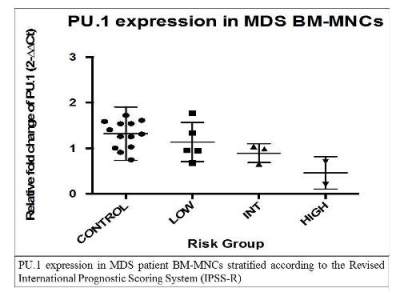PU.1 EXPRESSION CORRELATES WITH PATIENT DISEASE STATUS IN THE MYELODYSPLASTIC SYNDROMES, A NEW PROGNOSTIC MARKER?
(Abstract release date: 05/19/16)
EHA Library. Rinaldi C. 06/09/16; 134808; PB1908

Dr. Ciro Rinaldi
Contributions
Contributions
Abstract
Abstract: PB1908
Type: Publication Only
Background
Myelodysplastic syndromes (MDS) are a group of clonal hematopoietic stem cell disorders characterised by ineffective haematopoiesis and dysplasia, manifesting as variable degrees and combinations of peripheral blood cytopenia. The result is often transfusion-dependent anaemia, increased risk of infection, bleeding complications, and an increased potential of progression to acute myelogenous leukaemia (AML). In recent years treatment with 5-azacytidine (AZA) has seen an increase in patient survival for intermediate and high-risk group MDS patients, although the precise mechanism of action is not yet fully understood. Previous studies have demonstrated down regulation of the PU.1 transcription factor in high-risk MDS patients, which can be reversed by administration of AZA. However, it is not currently known if PU.1 levels correlate with MDS disease severity and/or prognosis.
Aims
Assess if PU.1 expression levels in MDS patients correlate with disease prognosis as determined by risk group stratification using the Revised International Prognostic Scoring System (IPSS-R). In addition, we will use commercially available cell lines (SKM-1, MOLM-13, K562, HL60) to explore the potential of AZA in correcting down-regulated PU.1 expression that is seen in high-risk MDS.
Methods
BM specimens were collected from 10 patients diagnosed with MDS who were stratified according to IPSS-R guidelines (5-low, 3-int, 2-high risk) and from 13 haematological normal controls. Samples were enriched for the mononuclear fraction by Ficoll separation. Total RNA was extracted and analysed by Real Time PCR for PU.1 expression relative to the housekeeping gene GAPDH using the 2-ΔΔCT method. In vitro models of MDS, SKM-1 and MOLM-13 were treated with 1 μM AZA for 24, 48, or 72hr followed by analysis of PU.1 expression analysis by RT-qPCR.
Results
Analysis of patient samples revealed that PU.1 expression is significantly lower in high-risk patients compared controls. In addition, preliminary data suggests that PU.1 expression also correlates with disease severity and could provide insight as a prognostic marker. PU.1 expression was significantly increased upon treatment with 1 μM AZA in commercially available cell lines.
Conclusion
PU.1 is found to be down regulated in high-risk MDS and it appears that expression correlates well with the IPSS-R classification of prognosis group. As such, PU.1 provides a potential biomarker for MDS diagnosis and progression. In addition, PU.1 expression in MDS in vitro models is increased by treatment with AZA providing a potential mechanism for AZA function in vivo.

Session topic: E-poster
Keyword(s): MDS, PU.1
Type: Publication Only
Background
Myelodysplastic syndromes (MDS) are a group of clonal hematopoietic stem cell disorders characterised by ineffective haematopoiesis and dysplasia, manifesting as variable degrees and combinations of peripheral blood cytopenia. The result is often transfusion-dependent anaemia, increased risk of infection, bleeding complications, and an increased potential of progression to acute myelogenous leukaemia (AML). In recent years treatment with 5-azacytidine (AZA) has seen an increase in patient survival for intermediate and high-risk group MDS patients, although the precise mechanism of action is not yet fully understood. Previous studies have demonstrated down regulation of the PU.1 transcription factor in high-risk MDS patients, which can be reversed by administration of AZA. However, it is not currently known if PU.1 levels correlate with MDS disease severity and/or prognosis.
Aims
Assess if PU.1 expression levels in MDS patients correlate with disease prognosis as determined by risk group stratification using the Revised International Prognostic Scoring System (IPSS-R). In addition, we will use commercially available cell lines (SKM-1, MOLM-13, K562, HL60) to explore the potential of AZA in correcting down-regulated PU.1 expression that is seen in high-risk MDS.
Methods
BM specimens were collected from 10 patients diagnosed with MDS who were stratified according to IPSS-R guidelines (5-low, 3-int, 2-high risk) and from 13 haematological normal controls. Samples were enriched for the mononuclear fraction by Ficoll separation. Total RNA was extracted and analysed by Real Time PCR for PU.1 expression relative to the housekeeping gene GAPDH using the 2-ΔΔCT method. In vitro models of MDS, SKM-1 and MOLM-13 were treated with 1 μM AZA for 24, 48, or 72hr followed by analysis of PU.1 expression analysis by RT-qPCR.
Results
Analysis of patient samples revealed that PU.1 expression is significantly lower in high-risk patients compared controls. In addition, preliminary data suggests that PU.1 expression also correlates with disease severity and could provide insight as a prognostic marker. PU.1 expression was significantly increased upon treatment with 1 μM AZA in commercially available cell lines.
Conclusion
PU.1 is found to be down regulated in high-risk MDS and it appears that expression correlates well with the IPSS-R classification of prognosis group. As such, PU.1 provides a potential biomarker for MDS diagnosis and progression. In addition, PU.1 expression in MDS in vitro models is increased by treatment with AZA providing a potential mechanism for AZA function in vivo.

Session topic: E-poster
Keyword(s): MDS, PU.1
Abstract: PB1908
Type: Publication Only
Background
Myelodysplastic syndromes (MDS) are a group of clonal hematopoietic stem cell disorders characterised by ineffective haematopoiesis and dysplasia, manifesting as variable degrees and combinations of peripheral blood cytopenia. The result is often transfusion-dependent anaemia, increased risk of infection, bleeding complications, and an increased potential of progression to acute myelogenous leukaemia (AML). In recent years treatment with 5-azacytidine (AZA) has seen an increase in patient survival for intermediate and high-risk group MDS patients, although the precise mechanism of action is not yet fully understood. Previous studies have demonstrated down regulation of the PU.1 transcription factor in high-risk MDS patients, which can be reversed by administration of AZA. However, it is not currently known if PU.1 levels correlate with MDS disease severity and/or prognosis.
Aims
Assess if PU.1 expression levels in MDS patients correlate with disease prognosis as determined by risk group stratification using the Revised International Prognostic Scoring System (IPSS-R). In addition, we will use commercially available cell lines (SKM-1, MOLM-13, K562, HL60) to explore the potential of AZA in correcting down-regulated PU.1 expression that is seen in high-risk MDS.
Methods
BM specimens were collected from 10 patients diagnosed with MDS who were stratified according to IPSS-R guidelines (5-low, 3-int, 2-high risk) and from 13 haematological normal controls. Samples were enriched for the mononuclear fraction by Ficoll separation. Total RNA was extracted and analysed by Real Time PCR for PU.1 expression relative to the housekeeping gene GAPDH using the 2-ΔΔCT method. In vitro models of MDS, SKM-1 and MOLM-13 were treated with 1 μM AZA for 24, 48, or 72hr followed by analysis of PU.1 expression analysis by RT-qPCR.
Results
Analysis of patient samples revealed that PU.1 expression is significantly lower in high-risk patients compared controls. In addition, preliminary data suggests that PU.1 expression also correlates with disease severity and could provide insight as a prognostic marker. PU.1 expression was significantly increased upon treatment with 1 μM AZA in commercially available cell lines.
Conclusion
PU.1 is found to be down regulated in high-risk MDS and it appears that expression correlates well with the IPSS-R classification of prognosis group. As such, PU.1 provides a potential biomarker for MDS diagnosis and progression. In addition, PU.1 expression in MDS in vitro models is increased by treatment with AZA providing a potential mechanism for AZA function in vivo.

Session topic: E-poster
Keyword(s): MDS, PU.1
Type: Publication Only
Background
Myelodysplastic syndromes (MDS) are a group of clonal hematopoietic stem cell disorders characterised by ineffective haematopoiesis and dysplasia, manifesting as variable degrees and combinations of peripheral blood cytopenia. The result is often transfusion-dependent anaemia, increased risk of infection, bleeding complications, and an increased potential of progression to acute myelogenous leukaemia (AML). In recent years treatment with 5-azacytidine (AZA) has seen an increase in patient survival for intermediate and high-risk group MDS patients, although the precise mechanism of action is not yet fully understood. Previous studies have demonstrated down regulation of the PU.1 transcription factor in high-risk MDS patients, which can be reversed by administration of AZA. However, it is not currently known if PU.1 levels correlate with MDS disease severity and/or prognosis.
Aims
Assess if PU.1 expression levels in MDS patients correlate with disease prognosis as determined by risk group stratification using the Revised International Prognostic Scoring System (IPSS-R). In addition, we will use commercially available cell lines (SKM-1, MOLM-13, K562, HL60) to explore the potential of AZA in correcting down-regulated PU.1 expression that is seen in high-risk MDS.
Methods
BM specimens were collected from 10 patients diagnosed with MDS who were stratified according to IPSS-R guidelines (5-low, 3-int, 2-high risk) and from 13 haematological normal controls. Samples were enriched for the mononuclear fraction by Ficoll separation. Total RNA was extracted and analysed by Real Time PCR for PU.1 expression relative to the housekeeping gene GAPDH using the 2-ΔΔCT method. In vitro models of MDS, SKM-1 and MOLM-13 were treated with 1 μM AZA for 24, 48, or 72hr followed by analysis of PU.1 expression analysis by RT-qPCR.
Results
Analysis of patient samples revealed that PU.1 expression is significantly lower in high-risk patients compared controls. In addition, preliminary data suggests that PU.1 expression also correlates with disease severity and could provide insight as a prognostic marker. PU.1 expression was significantly increased upon treatment with 1 μM AZA in commercially available cell lines.
Conclusion
PU.1 is found to be down regulated in high-risk MDS and it appears that expression correlates well with the IPSS-R classification of prognosis group. As such, PU.1 provides a potential biomarker for MDS diagnosis and progression. In addition, PU.1 expression in MDS in vitro models is increased by treatment with AZA providing a potential mechanism for AZA function in vivo.

Session topic: E-poster
Keyword(s): MDS, PU.1
{{ help_message }}
{{filter}}


